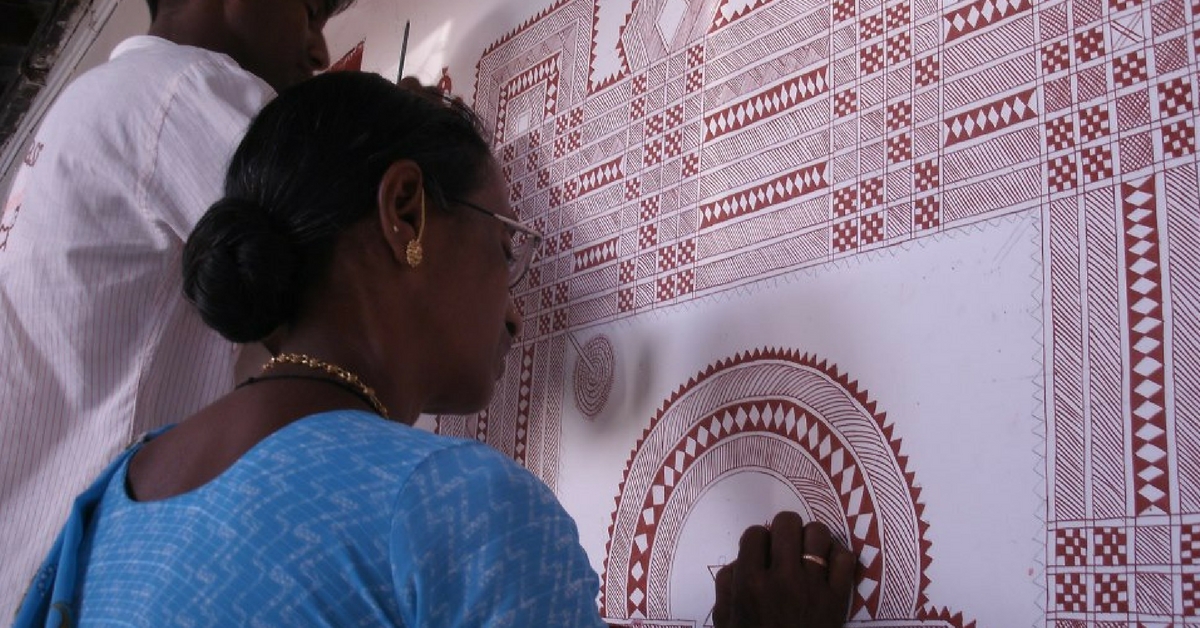Bengaluru may be Geeta Bhat’s hometown, but her heart is docked in Northern Karnataka. A conservationist and founder of Center for Revival of Indigenous Art, Geetha works tirelessly to promote the folk traditions, the arts and crafts of the Deevaru community that lives in the region.
Geeta’s tryst with the community began with her discovery of Chittara, an art form practiced by the community’s women.

Image source: Facebook
“I have always been interested in folk arts and often pitched as an art volunteer,” she says. “I saw my first Chittara art at an exhibition and it was love at first sight.”
Intrigued as she was, Geeta found little information readily available on the subject. Not one to give up, she explored on her own and found the information she needed, gradually making her way to Sagara village, home to the Deevaru community.
You might also like: If You Think Art Is Elitist, Chennai’s New Public Art Initiative Will Definitely Change Your Mind
Since then, Geeta has promoted the community through various initiatives, contributing to the revival of the art form that has been declining over generations.
“Chittara is done by the community’s women and is deeply personal — there’s one specific variety that must be created by women before their wedding ceremony,” Geeta says while praising the geometric precision, use of natural dyes and other intricacies of the folk art form. “The Deevaru have never tried to commercialise their art. I have tried to interpret the designs in murals and silk fabrics, but I don’t want to tamper with the authenticity of the art form.
Like many other rural and tribal communities around the country, the traditional ways of the Deevaru people are slowly vanishing in the face of poverty and modernization.
Geeta says, “Finances are a major concern, as is the lack of interest among the younger generation. They would rather watch television than master the art form, and motivating them can be quite difficult.”
Geeta and her organisation strive to offer fresh incentives for the Deevarus to preserve their heritage and cultural artefacts. “There’s much more to the community than Chittara art,” says Geeta. “The community has its own distinctive forms of silver jewellery, mat making, embroidery and textiles. The Deevarus may not be literate, but they are educated in their own way and engagement with their environment.”
CFRIA periodically organises exhibitions, workshops, and events, and develops a sustainable business model for the community. “CFRIA organised the first International Chittara exhibition in Japan and has also presented papers in three international conferences,” Geeta says. The varied products made by the community are also available in select outlets in Bengaluru.
Geeta is deeply invested in more than simply bringing the community’s art forms or craftsmanship into the limelight.
Image source: Facebook
Sagara, and the other villages in the region, have long been isolated from developmental projects. Much remains to be done in the region to provide the locals with new means of livelihood and uplifting their way of life.
CFRIA has numerous plans for the areas in and around Sagara, including a community centre to teach the art and generate livelihood, a resort for travellers to visit the community and engage with them, museums, a cafe and an amphitheatre.
However, these are still long-term goals, as the large funding required to execute these projects remains a major challenge. However Geeta remains optimistic. “I will set it up some day,” she says.
You might also like: This Initiative Is Helping Rural Artisans Create Masterpieces by Collaborating With Modern Artists
In the meantime, she is gearing up to start filming a documentary on the community later this year. “Making a documentary is quite expensive as well, but I have recently received some funds and will finally be able to start the project,” she says.
Not surprisingly, Geeta wants the movie to look beyond Chittara and be a cinematic record of the community’s traditions. “I want to document the lives of the community in all its beauty,” says Geetha, resolute in her mission to promote the little-known cultures of Karnataka.
To get in touch with Geeta Bhat, click here.
Like this story? Or have something to share? Write to us: contact@thebetterindia.com, or connect with us on Facebook and Twitter.
NEW: Click here to get positive news on WhatsApp!
If you found our stories insightful, informative, or even just enjoyable, we invite you to consider making a voluntary payment to support the work we do at The Better India. Your contribution helps us continue producing quality content that educates, inspires, and drives positive change.
Choose one of the payment options below for your contribution-
By paying for the stories you value, you directly contribute to sustaining our efforts focused on making a difference in the world. Together, let's ensure that impactful stories continue to be told and shared, enriching lives and communities alike.
Thank you for your support. Here are some frequently asked questions you might find helpful to know why you are contributing?

